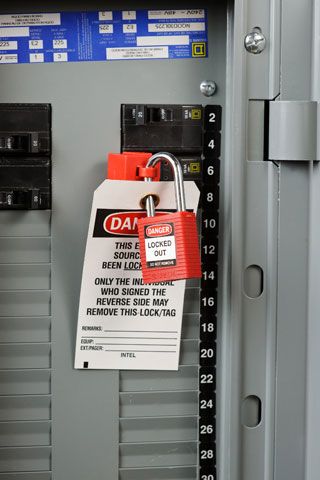Labels for Safety, Visuals and Facility ID Desktop Printers
Labels for Product, Wire and Lab ID Benchtop Printers
Labels for Safety, Visuals and Facility ID Desktop Printers
Labels for Product, Wire and Lab ID Benchtop Printers
Safety and Facility ID Desktop Printers
Product, Wire and Lab ID Benchtop Printers
Barcode Scanner and Printer Kits
Barcode Scanner and Printer Kits
PaintStripe Floor Marking Stencils
Valve Lockouts & Hose Lockouts
Group Lock Boxes & Permit Control
Brady Safety Lockout Tagout Services
Pipe Marker Accessories & Mounting Brackets
Maintenance and Production Tags
Calculators and Assessment Tools
Product Finders and Data Sheets
How to create a sustainable lockout tagout program
that keeps your workers safe
The best way to ensure compliance with OSHA’s Control of Hazardous Energy (Lockout Tagout) regulatory standard is by creating a robust lockout tagout program that:
Sounds simple enough, right? The truth is a typical lockout tagout program can contain over 80 elements. Read on to better understand the 6 key elements that go into a successful lockout tagout program.

OSHA’s Control of Hazardous Energy regulation requires that energy sources must be contained during servicing and maintenance to ensure worker safety. Energy sources can include electrical, mechanical, hydraulic, pneumatic, chemical, thermal or other sources in machines and equipment.
When such hazardous energy sources are not properly controlled, workers servicing or maintaining the machines or equipment may end up seriously injured or even killed.
The regulatory standard (29 CFR 1910.147) also requires that:
“The employer shall establish a(n) (energy control) program consisting of energy control procedures, employee training and periodic inspections to ensure that before any employee performs any servicing or maintenance on a machine or equipment where the unexpected energizing, startup or release of stored energy could occur and cause injury, the machine or equipment shall be isolated from the energy source and rendered inoperative."
Year after year, lockout tagout compliance continues to appear on OSHA’s Top 10 Cited Standards list. The majority of those citations are due to a lack of proper lockout procedures, program documentation, periodic inspections or other procedural elements. Luckily, the following outlined key elements for a lockout tagout program will help you keep your workers safe and avoid becoming a statistic due to non-compliance.
The first step to lockout tagout success is developing and documenting your equipment energy control policy/program. A written lockout document establishes and explains the elements of your program.
It's important to take into account not only OSHA's guidelines, but also custom requirements for your employees to ensure they can understand and apply the program to their workday.
A program is not a one-time fix; it should be reviewed on an annual basis to ensure it's still relevant and effectively protects employees. Creating a lockout program should be a collaborative effort from all levels of the organization.


Lockout procedures should be formally documented and clearly identify the equipment covered. The procedures should detail the specific steps necessary for shutting down, isolating, blocking and securing equipment to control hazardous energy, as well as steps for the placement, removal and transfer of lockout / tagout devices.
Going beyond compliance, we recommend creating best practice procedures that include machine-specific photos identifying energy isolation points. These should be posted at the point of use to provide employees with clear, visually intuitive instructions.
Locate and identify all energy control points — valves, switches, breakers and plugs — with permanently placed and standardized labels or tags. Keep in mind that these labels and tags should be consistent with the equipment-specific procedures from Step 2.


Be sure to adequately train your employees, communicate processes and conduct periodic inspections to ensure your program is running effectively. Training should not only include OSHA requirements, but also your own specific program elements, such as your machine-specific procedures.
When OSHA evaluates a company’s lockout tagout compliance and performance, it looks for employee training in the following categories:
With so many products on the market designed to help keep your employees safe, selecting the most appropriate solution for your application is the key to lockout effectiveness. Once selected, it's important to document and use devices that best fit each lockout point.

Your lockout tagout program should always be continuously improving, which means it should include regularly scheduled reviews. By consistently reviewing your program, you are creating a safety culture that proactively addresses lockout tagout, allowing your company to focus on maintaining a world-class program. It also saves time because it prevents you from having to start from scratch each year and reacting only when something goes wrong.
Not sure if you can maintain the sustainability costs? Programs that lack sustainability tend to have higher costs in the long run, because the lockout tagout program must be recreated each year. By simply maintaining your program throughout the year, you'll enhance your safety culture and use fewer resources because you won't need to reinvent the wheel each time.
When looking at your program from this perspective, it's clear that a sustainable program helps you stay one step ahead, while saving time and money.
Take your lockout program to the next level with standardization. Standardizing your program can go a long way in ensuring the safety of your employees and your overall compliance of the regulation.
A standardized lockout program benefits you and your facility by:
Establishing consistent expectations
Reducing time spent on audits
Improving usage and safety
Simplifying
training
Increasing accountability

Fostering a consistent safety culture
Brady provides a start-to-finish solution, which means we can jump in and help at any stage of your lockout tagout program development. Rely on our in-house team of industry experts to work with you to create a sustainable and compliant safety program supported by:
Learn more about our lockout tagout solutions at bradyid.com/solutions.
Read more about Lockout/Tagout Inconsistencies in the Brady article with Safety and Health Magazine.
Developing a compliant Lockout Tagout program can be difficult to create and maintain. Our Safety Services team is here to help.

Learn more about Lockout Tagout compliance with “The Safety Professionals Expanded Guide to LOCKOUT TAGOUT”
Download
Learn what equipment you need to effectively use lockout tagout in your facility with our downloadable checklist.
Download
See what other Safety Managers are most commonly asking about the lockout tagout standard.
View FAQ's